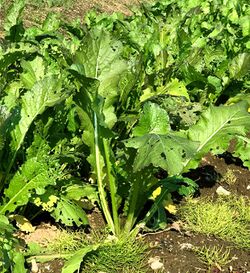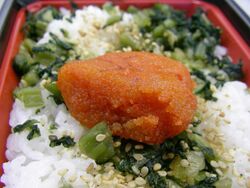Biology:Nozawana
From HandWiki
Revision as of 18:20, 26 April 2022 by imported>Raymond Straus (simplify)
Short description: Japanese leaf vegetable, often pickled
| Nozawana | |
|---|---|

| |
| Nozawana | |
| Scientific classification | |
| Kingdom: | Plantae
|
| (unranked): | |
| (unranked): | |
| (unranked): | |
| Order: | |
| Family: | |
| Genus: | |
| Species: | B. rapa (syn B. campestris)
|
| Variety: | B. r. var. hakabura
|
| Trinomial name | |
| Brassica rapa L. var. hakabura | |
Nozawana (野沢菜, Brassica rapa L. var. hakabura) is a Japanese leaf vegetable, often pickled.[1] It is of the same species as the common turnip and one of a Japanese variety of mustard leaf.[2] Its leaves are approximately 60–90 cm long.
Traditionally it is thought that sometime between 1751 and 1764 the plant was brought from the Kyoto mountains to the Nozawa-onsen village by the master of a Buddhist temple who lived in Nozawa. It was since cultivated around that area, and thus named Nozawana: na means vegetable in Japanese.
Pickled nozawana is one of the most typical local foods in Nagano Prefecture. It is also used in onigiri.[3]
References
- ↑ "Nozawana - the perfect pickle in Nozawa Onsen" (in en-AU). 2016-08-16. https://www.nozawaholidays.com/news/nozawana-perfect-pickle-nozawa-onsen/.
- ↑ "Pickled Mustard Leaves (Nozawana-zuke)" (in en-AU). 2017-07-17. https://asianinspirations.com.au/recipes/pickled-mustard-leaves-nozawana-zuke/.
- ↑ "Japanese Savoury Buns (Nozawana Oyaki)" (in en-AU). 2017-07-17. https://asianinspirations.com.au/recipes/japanese-savoury-buns-nozawana-oyaki/.
Wikidata ☰ Q3049961 entry
 |


